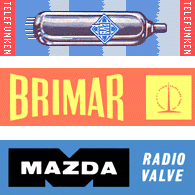~ VALVES for SALE ~ December 2024 ~


For many years this section of my website listed some thermionic valves I had for sale and I still have hundreds for Sale ~ They are mainly British or US made Vintage parts which are tested to the Manufacturers or AVO 163 specification before shipping ~ They are either New Old Stock or lightly used and may have logos rubbed due to handling and may not be in the manufacturers original boxes but they are all good quality items
Refreshing the listings and trying to keep them in line with ebay and other crazy prices was a thankless task so I now ask ~ If you need a particular valve please contact me and I will check what I have ~ I may may also be able to match the type and style of the one you need if you send clear pictures of the valves you want to match
~ When Tested Correctly ~ Valves should not "test strong" ~
![]() When measured using the correct method and reference data valves should never be described as testing strong or more than 100% ~ This suggests that the valve is conducting more anode current Ia than it should for the specified negative control grid voltages Vg1 and Vg2 and indicates that the static gain is out of specification
When measured using the correct method and reference data valves should never be described as testing strong or more than 100% ~ This suggests that the valve is conducting more anode current Ia than it should for the specified negative control grid voltages Vg1 and Vg2 and indicates that the static gain is out of specification
At a higher anode current Ia than specified the mutual conduction gm will also be higher but this greater than 100% gm may not be achieved in practice with auto–bias or even desirable for some designs ~ Valves sold as testing more than 130% should be considered out of spec especially if with Ia greater than specified gm is lower than specified
According to most manufacturer and valve meter data a correctly measured gm of as low as —50% is still considered GOOD but this is also end of life [ EOL ] ~ A problem with most valve testers [ Not the AVO 163 Valve Characteristic Meter ] is if the static condition is not correct then gm measured by 'backing off' is meaningless
There are valve test conditions other than Ia and gm that also need to be tested which include cathode to heater insulation CH and positive grid current due to GAS or an imperfect vacuum ~ These measurements need to be made after some time when the valve has reached its operating temperature and are often overlooked so when purchasing from places like ebay you should ask how they have been measured and with what type of meter
The AVO 163 Valve Characteristic Meter provides for measuring the screen grid current Ig2 and its gain gmg2 ~ This measurement often proves very useful and can highlight problems with modern copies of classic valves like the PM Components retro look KT66 where the g2 current and gmg2 are almost non existent due to bad alignment between grids g1 and g2 which prevents these and some other tetrodes from performing correctly in circuits like the QUAD II and some 'Ultra Linear' designs although they are often okay when triode connected
![]() When testing valves like a CV5112 that have high gm >10 it is often difficult to get meaningful readings with most valve testers and some give over optimistic results ~ For high gm valves [ and others ] the most meaningful test is the gm measured at a fixed and stable Ia ~ When the specified Ia is achieved at low Vg1 as occurs with high gm valves the Vg1 value is not important and in practice these valves should be run with constant anode current and in their original designs like telephone repeater amplifiers thay were fed in series from high voltage constant current supplies
When testing valves like a CV5112 that have high gm >10 it is often difficult to get meaningful readings with most valve testers and some give over optimistic results ~ For high gm valves [ and others ] the most meaningful test is the gm measured at a fixed and stable Ia ~ When the specified Ia is achieved at low Vg1 as occurs with high gm valves the Vg1 value is not important and in practice these valves should be run with constant anode current and in their original designs like telephone repeater amplifiers thay were fed in series from high voltage constant current supplies
For an explaination of the codes used by some valve manufacturers see here
At present I am selling some of my many NOS RCA and good used Brimar and Mullard
6SN7 — 12AT7 — EC90 — 12BH7 — 6V6GT — email me using link below
Dynamic testing and comparison of valves using a TEK 576 curve–tracer

 Testing with a Tektronix 576 or similar curve tracer will often show differences in valves that are not obvious from the single static point Ia and gm testing available with a valve tester — It may also show that modern 'equivalent' valves do not match the characteristics of the original items which may explain reported differences between NOS and used vintage valves and some modern replacements See also
Testing with a Tektronix 576 or similar curve tracer will often show differences in valves that are not obvious from the single static point Ia and gm testing available with a valve tester — It may also show that modern 'equivalent' valves do not match the characteristics of the original items which may explain reported differences between NOS and used vintage valves and some modern replacements See also







" Got a case of dynamite ~ I could hold out here all night "
![[keith-snook.info]](stuff/keith-info-xmas.png)